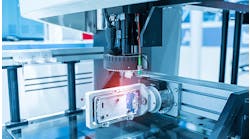In machine automation terms, linear measurement is not just a measurement of length; it's a one-dimensional measurement of a position. However, two- and three-dimensions of measurement should be considered because error, in any dimension, can change the measurement based on position. As a linear actuator, gantry or pallet moves, the positional error can change, as well; some error adds up, but some reliably repeats. There is much to consider when adding position feedback to a machine controller.
There are many ways to determine position of an actuator or part in machine automation. Some are simple; some are complex; some are accurate; some are not. The starting point for linear measurements in a machine is understanding the position requirements to properly assemble, machine or otherwise affect the final product. What are the part assembly requirements, and how tight are final part tolerances?
Do you need accuracy or repeatability in your linear measurement? Yes. You need both, but sometimes one is more important than the other. What about linearity and resolution? Sure. Which is more important? It likely depends on the measurement device, sensor sales guy and the application. Sometimes several are important, but one bad apple can upset the cart. What do you have to have in the way of machine position measurement?
Accuracy, the correctness of the measurement at any point in the measurement range, is important for CNC machining applications. In this case the part needs to be made to a tolerance, so the measurement needs to be close to the actual value in maybe five or more axes. Accuracy is critical in this case. However, good repeatability—how close is the measurement each time it is made—may be all that is necessary in other applications. An actuator may only need to move to a repeatable position each automatic machine cycle, for example. And, to add another term, the Six-Sigma and metrology guys like to refer to repeatability as precision, and then they'll talk reproducibility. Have fun with that.
ALSO READ: These 3 linear measurement techniques go the distance
When it comes to linearity, I think of it as accuracy. A non-contact magnetostrictive position sensor, for example, may have a linearity of +/-0.02% of full scale. That's approximately +/-100 µm linearity for a 500 mm measurement range sensor. The specification lists repeatability of this device at +/-3µm. It's 33 times more repeatable than its full-scale linearity, which is the measurement accuracy of the analog position output from the device. A stepper motor on a machine using this device to close its position loop would have very good repeatability moving to within 3µm of individual position set points. The same device may not be very accurate if programmed to move 100 mm from any relative position in its travel range, based on its specifications.
Resolution of the measurement device plays into accuracy, repeatability and linearity. Too coarse of resolution on a magnetic scale sensor or too few of pulses per revolution in an encoder may hurt accuracy and repeatability. The resolution in an encoder or analog circuit must be finer than the measurement tolerance for proper assembly or machining. A resolution of 20% to 30% of the measurement tolerance usually works. Some will say even a finer resolution is needed, but too much can cause noise in the measurement.
A rule of thumb, often heard in machine shops, is that the measurement repeatability should be 10 times better than required for the application. The end results should pass an in-house gage repeatability and reproducibility (GR&R). Results will differ, so study up on some statistics and other good measurement practices for more information.
Got Position?
Not to delve too deeply into component considerations, but there are many forms of linear measurement in automation. My favorite is machine vision. Calibrate the image pixels to engineering units and then calibrate a robot's coordinates to the image plane as well and, voilà, vision-guided robots. Okay, that's two dimensional but it is very common today.
Some linear measurement in automation is like a tape measure. The linear encoder, magnetostrictive position sensor and magnetic scale position sensor are examples. However, a rotary encoder can also provide linear measurement to determine a machine actuator's position. A cable actuated position sensors or draw wire pull cord are examples. An encoder on a servo motor for positioning a linear actuator or slide is another example. The actual linear position of the actuator is calculated based on the encoder count and actuator mechanics, such as gear ratio or ball screw pitch. The mechanical specifications of the actuator, encoder resolution, servo-motor tuning and even the servo-to-ball-screw coupling can affect accuracy and repeatability. The position errors can and will add up, and approaching a position from the opposite direction can make it worse.
Other linear measurement devices include an LVDT that must contact the measured surface and laser displacement measurement, which is contact-free. Both devices and many similar measurement methods provide very good accuracy and repeatability specifications, in many cases less than a few microns.
Whether measuring the surface of a semiconductor die with sub-micron accuracy or the position of a gantry over a 12-station, 54-foot tin plating line, there is a linear-measurement device to do the job. Carefully consider the cost of failed, inaccurate or non-repeatable measurements and find the actual position.






